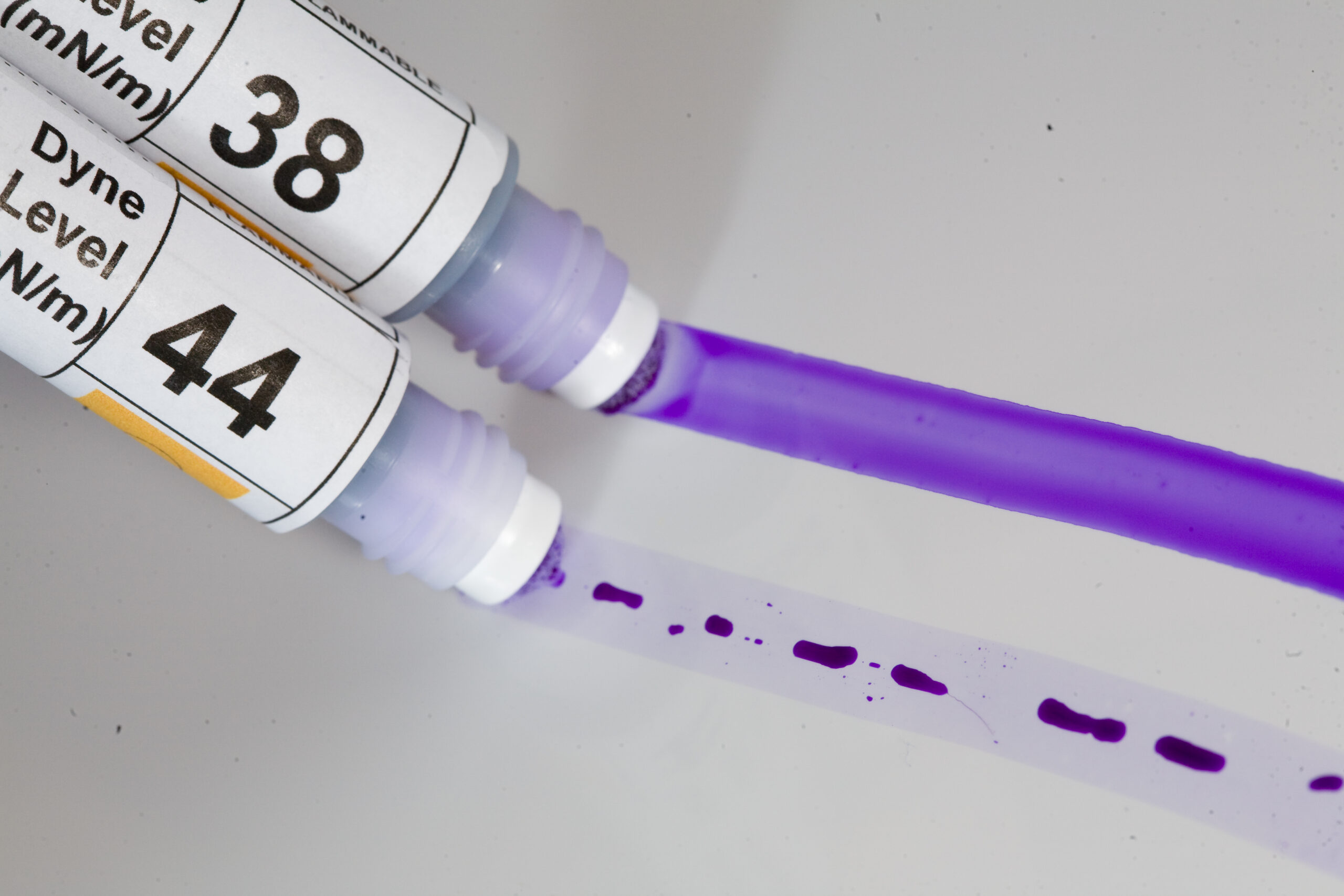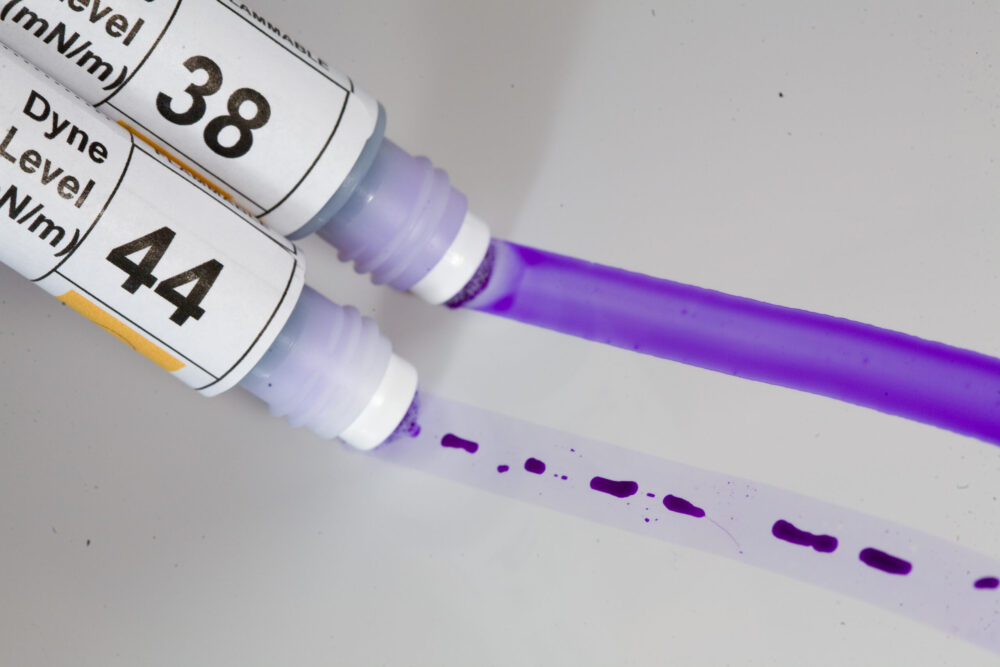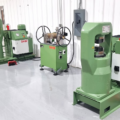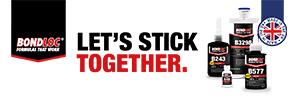~ Getting the best out of simple surface energy measurement ~
Understanding a substrate’s surface energy is a worthwhile part of any bonding or coating process – or any process which involves adhesion. During the specification phase, there is a need to understand surface energy and wettability in a quantitative way, to ensure adhesion. In the production phase, measuring surface energy takes on a more qualitative and process control function. Dyne Pens and Inks can be used to assess surface energy and wetting. Here, Alison Fox, Sales Manager of Dyne Testing, an Intertronics brand, outlines some hints and tips when using Dyne pens.
If you are printing, painting, bonding or sealing, good adhesion is an essential issue. If you do not understand the surface energy of the adhesive material and the substrate, and the difference between them, you risk issues with wetting, the quality of adhesion, and complete coating coverage. This applies in material and substrate specification phase, where you might want quantitative data. In the production phase, checking surface energy can help you determine process failures (e.g. cleaning, surface preparation like corona or plasma treatment) or other unintended surface changes.
Dyne pens are handheld surface energy analysis tools that can be used in any environment on solid substrates. They are available in different “Dyne” levels. When a Dyne test pen is applied to the surface, the ink will either form a continuous film on the surface, or pull back into small droplets. If the liquid remains a film for three seconds, the surface energy of the substrate has a minimum value of that Dyne pen ink value. If the ink draws back, then the surface energy of the substrate is lower than that of the ink. The exact surface energy can be determined by applying various Dyne pens or inks, which provide a rapid indication of the surface energy of the material. Alternatively, by using a Dyne pen to test for a minimum acceptable Dyne level, the technique becomes a simple but effective go/no-go process.
By consistently following the standardised test procedure and choosing the Dyne pen range suitable for the application, users see consistent and repeatable results. With the advantage of being quick and relatively inexpensive, Dyne pens have become a popular and ubiquitous tool in many industrial and laboratory settings. To help get the best results, here are some hints and tips.
Avoiding contamination
Common mistakes when using the pens include testing on a contaminated area of the material. It is important that tests take place on areas that haven’t been handled. If users test on areas contaminated by fingerprints, the results will likely be inaccurate and inconsistent across the material. This leads to rejections, wasted resources, and reduced productivity.
Visual checks are usually enough to identify contamination like grease marks, dust, or fingerprints. Testing in these areas will not give a true analysis of the underlying substrate’s surface energy. It is good practice to test in three areas of the substrate sample; inconsistent results will indicate some form of localised problem (contamination, surface treatment failure, etc), whereas identical results will give confidence in the validity of the measurements.
We recommend that tests are conducted at room temperature and humid environments are avoided. Evaporation, water vapour, and airborne contaminants can all affect the Dyne level result. For the same reasons, we recommend that Dyne pens are stored at ambient temperatures with the caps on to ensure complete shelf life.
Pen choice
It is a good idea to use Dyne pens with a “valve tip” applicator, a type of pen that has a non-return valve. When pressing the tip firmly down, the valve is opened and fresh ink floods the applicator tip. The valve protects the testing ink inside the pen from humidity and from substrate contaminants which could otherwise wick up into the ink reservoir. It also means low levels of evaporation of volatiles from the ink, and prevents ink leakage. Unlike those based on a normal felt-tip marker pen, the valve tip applicator protects the ink and its integrity – keeping the results accurate for the lifetime of the pen and ensuring the best shelf life.
Material use
While Dyne Pens are suitable for most non-absorbent materials, including on polyethylene and polypropylene films, it is important for users to initially test on scrap substrate. This is to check the ink from the pens does not adversely react with the material being tested, soak into the material, or cause it to swell. On soft grades of PVC, the ink from the pen can react with the polymer and cause inaccurate results. A chemical reaction between the test fluid and the substrate invalidates results altogether.
It is important that the test fluid does not alter the substrate’s surface properties. For example, if the test fluid permeates a fibre substrate, such as paper, and causes swelling, results will indicate unrealistically easy wetting.

Timing is everything
The standard procedure entails applying the test ink and watching to see if it wets the substrate and for how long. An accurate test result will be with an ink that stays in a continuous film for between one and three seconds. If the ink stays wetted for more than three seconds, using a higher Dyne level test pen is indicated to narrow down the actual surface energy.
Summary
Dyne pens have found countless applications throughout industry, in research, product development, process control, incoming inspection, and finished product verification. Following the standard testing procedure is essential to successful use. Dyne Pens provide an analysis of a substrate surface energy, giving fast and cost-effective results. To find out more about Dyne Testing’s range of Dyne pens, visit www.dynepens.co.uk or contact [email protected].








